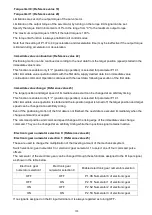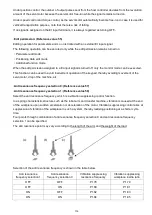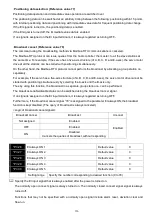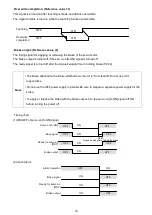
126
If P2.40
(internal positioning data selection) is “0” (disable), positioning is made according to the position data
and speed data sent via RS-485 communications.
Check for the active state of the in-position signal (level) to turn the start positioning signal on. The motor
starts to rotate. After rotation begins, the in-position signal is turned off.
If no signal is assigned on the EI input terminals, it is always regarded as turning OFF.
·Homing [ORG]: (Reference value 5)
·Home position LS [LS]: Reference value 6)
A homing motion is executed and the home position is determined.
These functions are enabled only if the extension mode (parameter P1.01= 6) and the positioning operation
(parameter P1.01=7) are selected.
The rising edge of the homing signal starts a homing motion.
The homing motion follows the settings of P2.06 through P2.18.
·Over-travel in positive direction [+OT]: (Reference value 7)
·Over-travel in negative direction [-OT]: (Reference value 8)
These signals are input signals of the limit switch which prevents the over travel (OT) at the end in the
machine travel direction.
Each signal is always enabled except under torque control.
If the over-travel signal is turned off, controlled stop is caused within the limit specified in P2.60 (third torque
limit).
If an OT signal is detected during positioning operation, the servomotor is forcibly stopped and therefore
difference may be caused between the command position and feedback position.
Take care of the reference value and sensor position so that the OT signal will not be detected during regular
operation.
If no signal is assigned on the EI input terminals, it is always regarded as turning OFF.
·Forced stop [EMG]: (Reference value 10)
This signal is used to forcibly stop the servo motor.
The servo motor is forcibly stopped while the forced stop [EMG] signal remains turned off.
This signal is enabled in all control modes and it is given the highest priority. Because the safety and detection
speed are significant, the forced stop signal is generally connected to the servo amplifier directly.
A self-locked pushbutton switch (command switch) provided on the operation panel or similar is connected in
regular cases.
If forced stop is turned off during operation, controlled stop is caused within the limit specified in P2.60 (third
torque limit).
If no signal is assigned on the EI input terminals, it is always regarded as turning ON.
·Alarm reset [RST]: (Reference value 11)
The alarm reset signal resets alarm detection of the servo motor drive.
The rising edge of the alarm reset [RST] signal resets alarm detection.
If no signal is assigned on the EI input terminals, it is always regarded as turning OFF.
















































